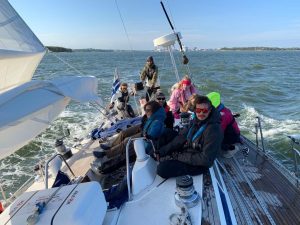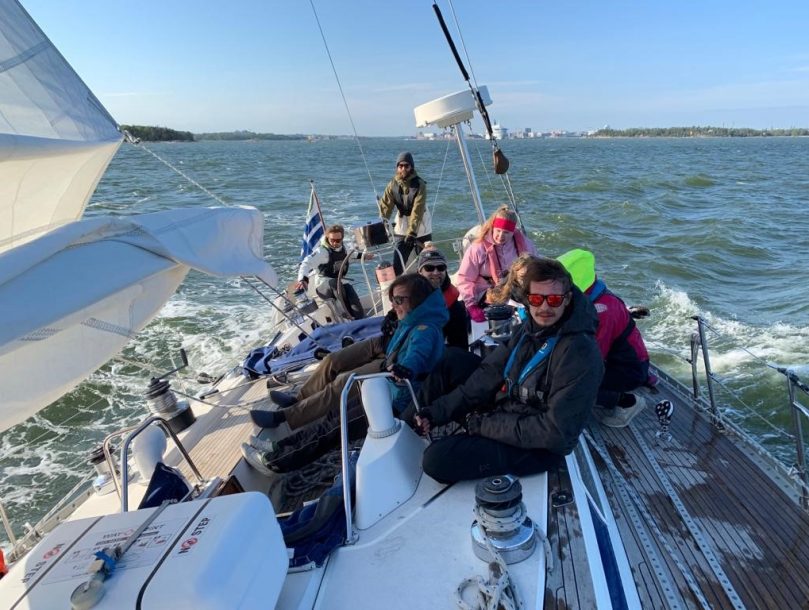Self-leadership is the core of all the other leadership roles and a well functioning group. The idea of self-leadership is that you are aware of your skills, what you are capable of doing, and how you react to certain things.
Alisa Denisov & Markus Mela, 2nd year bachelor’s degree students in the Adventure and Outdoor Education programme
According to the NOLS Leadership Educator Notebook (Gookin, 2004), there are four different leadership roles: Designated Leadership, Active Followership, Self-Leadership and Peer Leadership. In the following, we want to present those along with short explanations and examples of how these leadership roles are seen in our studies.
Designated Leadership
A designated leader is a person who has been chosen somehow to do the task and is in charge of the group’s actions. Usually, this person has a special education and knowledge, or the most experience to be able to be in this role.
The group can have a lot of knowledge in the field they are working on, but the designated leader has the skill set of leading and is aware of the bigger picture of the field. The group can also be total novices and the designated leader is showing and guiding them to a whole new thing.
For example, in our studies, our class has a quite wide set of skills and some topics and activities may be already familiar to some and to some they might be totally new; that’s why we still have the teacher who definitely knows the topic of the lecture and is in charge of the actions.
A designated leader has always the last call, so during hard situations the person will make the decision if there are many options on how to proceed.

The leader knows the area and shows the group where to go (Photo: Benjamin Hammond)
Active Followership
Active followership is nice manners which will make the group function smoother and that way the leader’s job easier. It basically means following the leader’s orders and being self-imposed.
For the group to be active followers they need to be motivated to work towards the group’s goals. The leader plays a big role in motivating them and by succeeding in this, the leader again makes her/his own job easier.
In our studies active followership plays a big role because everybody gets to be the leader at some point, so also you want to treat your leader as you would want to be treated yourself. Also, everybody is working towards the same goals during our projects.

Demonstrating Active Followership and following captain’s orders is essential for the crew’s and ship’s safety, (Photo: Ville Kankkunen)
Self-Leadership
Self-leadership is the core of all the other leadership roles and a well functioning group. The idea of self-leadership is that you are aware of your skills, what you are capable of doing, and how you react to certain things. By knowing these things, you are able to handle the tasks which come your way. For example, you know you are a slow biker so you leave early enough to give yourself enough time to get to school. Or you know that you are not that experienced in orienteering so you ask for help from your classmates before your leading part of the hike tomorrow. When you handle your self-leadership, your other leading roles become more efficient because you don´t have to stress about your own behaviour.
Peer Leadership
The power peer influence has on human development has been studied and well documented in many research papers and books[1]. As Kukoff (2013) points out, it is more or less a given that kids follow the examples set by other kids, both good and bad, which, conventional wisdom dictates, mostly comprises the latter. After all, we are always hearing that familiar phrase, “peer pressure,” whenever we are being told by counselors not to do drugs, or to drink and drive, or to be sexually promiscuous. But as easy as it is to talk about the negative aspects of peer pressure, I believe that the opposite is also true—that it is just as easy to find teenagers setting positive examples for their peers to follow, and subsequently recruiting those peers to do good.“[2]
Since we feel generally more involved with and related to our peers than to „official“ leaders, the examples set by members of our own group are by far more impressive and educational. Thus, peer leadership can be effectively used in education and to facilitate and encourage learning.

Two students leading the group‘s way on a hike as peer leaders (photo: Kai Lehtonen)
In our studies we use peer leadership quite often. When we have to conduct workshop days for different groups, the group and team leaders are always students, our peers. So, all the other students can see how they handle the situation and deal with difficulties. If they master it well, there is a lot to learn from their example; if not, the problems can be discussed and solved with the help from the other students.
By leading our own way we can discover our strengths and weaknesses and become aware of matters that could be improved. So, peer leadership is not only a good way to learn how to master leadership, but also to improve self-awareness and confidence.
[1] https://www.ellucian.com/insights/how-peer-leadership-improves-student-success 05.12.2019
[2] Kukoff, Zak 2013. The Autism Ambassadors Handbook: Peer Support for Learning, Growth, and Success. United States of America: Corwin.
References
Gookin, John 2004. NOLS Leadership Educator Notebook. National Outdoor Leadership School.
Kukoff, Zak 2013. The Autism Ambassadors Handbook: Peer Support for Learning, Growth, and Success. United States of America: Corwin.
Latosuo, Eeva 2019. Leadership in adventure education course, lecture materials, Autumn 2019. Humak University of Applied Sciences, Nurmijärvi
https://www.ellucian.com/insights/how-peer-leadership-improves-student-success 05.12.2019


